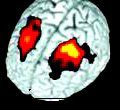Professor Gert Holstege, from Groningen University, is doing some elegant and handsome research on the neurological dimension of sex, thanks to latest generation brain scanners.
Volunteers, 11 men and 13 women, came to his Neuroscience lab with their respective partners, having agreed to be injected with a dye that shows changes in brain function on a scan and to lay on the scanning machine bed in hankypanky experimental conditions.
For studying orgasm the experimental apparatus revealed itself useless for men. A pattern of brain activity that takes less than two minutes is not detected by the scan so the few seconds of men's ejaculation is like a non-event in the sex-seismograph..
Women are different though, they climax for a sufficient amount of time for the brain scanner to show wonderful changes in coloured areas of the computer generated image.
Forget about media hype on 'fake-orgasm detectors' by your bed, what is really impressive is this find that during orgasm "there was strong, enormous deactivation in the brain". The parts of the brain that govern fear and anxiety are switched off, apparently. You can elaborate on that in two ways. On one hand it means you have a concrete neurological evidence to substantiate the well known subjective feeling of "loosing yourself" at the time of Big O. When, so to speak, something happens in a territory beyond fear and other negative vibes. On the other hand, it might be said that in the absence of fear and anxiety it might be easier to reach orgasm (a bit like re-inventing the wheel, really).
Anyway, the idea that one of the most deliberately addictive phenomena in the animal kingdom (crucial to keep reproductive instincts alive) is not only the active endorphin-producing flash, we took for granted, but also a Zen-like switching off of all "useless" brain areas has a certain philosophical beauty..


No comments:
Post a Comment